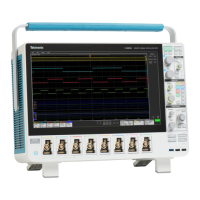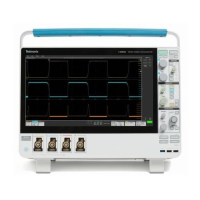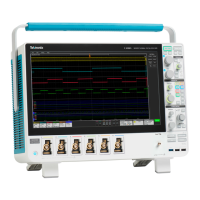Commands listed in alphabetical order
interpolated m
idpoint of the recovered unit interval. This measurement is made
on each non-transition bit in the record.
TOP is the most
common data value above the midpoint of the waveform. This
measurement can be made across the entire record, or on each cycle in the rec o rd.
UNITINTERV
AL
(Unit Interval) is the time difference between two successive bits.
This measurement is made on each bit in the record.
VDIFFXOVR (
Differential Crossover) is the voltage level of a differential signal
pair at the crossover points. This measureme nt is made at each crossover point
in the record.
WIDTH (Eye Width) is the minimum horizontal eye opening at the user specified
reference level. This measurement is made ac ross the entire record.
WIDTHBER (Eye Width@BER) is the predicted horizontal eye opening that will
be violated with a probability equal to the bit error rate. This measurement is
made across the entire record.
Examples
MEASUREMENT:MEAS2:TYPE FREQUENCY defines measurement 2 as a
measurement of the frequency of a waveform.
MEASUREMENT:MEAS1:TYPE? might return :MEASURE MENT:MEAS1:TYPE RMS,
indicating that measurement 1 is defined to measure the RMS value of a waveform.
MEASUrement:MEAS<x>:WINDOWLENgth
This command sets or queries the window length for the measurement. The
measurement number is s
pecified by x.
Group
Measurement
Syntax
MEASUrement:MEAS<x>:WINDO WLENgth <NR3>
MEASUrement:MEAS<x>:WINDO WLENgth?
Arguments
<NR3> is the value for the window length.
Examples
MEASUrement:MEAS1:WINDOWL ENgth 10 sets the window length to 10.
MEASUrement:MEAS1:WINDOWL ENgth? might return
:MEASUREMENT:MEAS1:WINDOW LENGTH 10.0000 indicating the
window length is 10.
2-494 MSO54, MSO56, MSO58, MSO58LP Programmer

